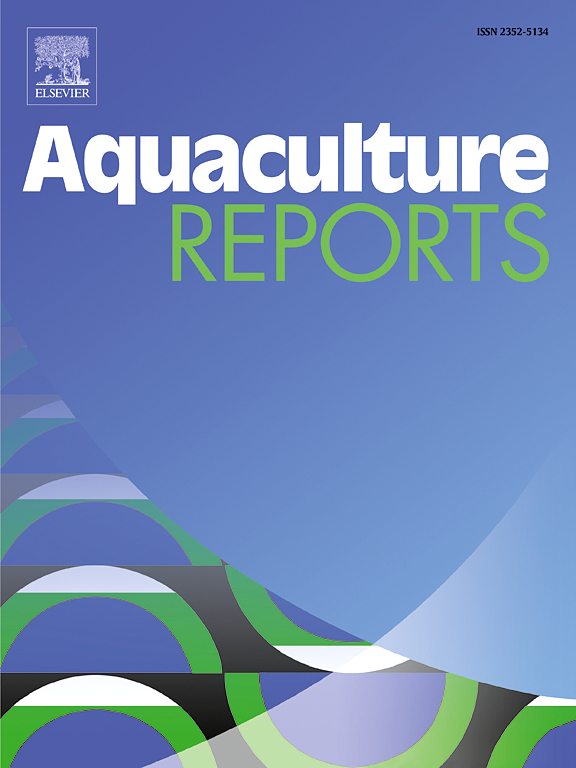鱼塘碳排放与碳埋藏的平衡:初级生产者和管理方法的作用
IF 3.2
2区 农林科学
Q1 FISHERIES
引用次数: 0
摘要
在全球碳循环中,池塘可以扮演双重角色:既能通过沉积作用储存碳,又是重要的温室气体排放源。在欧洲的所有池塘景观中,许多都是由人类管理用于养鱼的,如今人们对它们作为碳汇或碳源的作用知之甚少。在 2022 年的一个生产季节,我们对法国 Dombes 地区的 20 个鱼塘进行了监测。我们测量了三个不同季节(春季、夏季和秋季)的沉积速率、二氧化碳、甲烷和一氧化二氮的扩散量以及甲烷的沸腾量,以估算每个池塘的碳平衡。作为管理周期的一部分,其中五个池塘于 2023 年干涸,并在此期间对干通量排放进行监测。平均而言,我们的测量结果表明,鱼塘是碳汇(6 个鱼塘为碳源,14 个鱼塘为碳汇)。在 6 个月内,平均每公顷净固存 4.16(+/- 10.00)吨二氧化碳当量。干旱年份的测量结果表明,池塘是碳源(平均排放 23.89 吨二氧化碳当量)。不过,虽然干涸阶段直接增加了排放量,但它也促进了大型植物在随后几年的发展,从而通过沉积作用提高了碳储存量,这似乎也是观测到的平衡的一个重要驱动因素。这些数据表明,鱼塘有能力成为大气中的碳源或碳汇。此外,通过促进良好的初级生产力水平、水生植物的存在以及改善碳储存,管理方法似乎有能力将鱼塘变成碳汇。因此,这些农业生态系统可以在减缓气候变化方面发挥重要作用。本文章由计算机程序翻译,如有差异,请以英文原文为准。
The balance of carbon emissions versus burial in fish ponds: The role of primary producers and management practices
In the global carbon cycle, ponds can play a dual role: they have the capacity to store carbon through sedimentation, but also to be important greenhouse gas emitters. Of all the pond landscapes in Europe, many are managed by Humans for fish production and little is known today about their role as carbon sinks or sources. We monitored 20 fish ponds from the Dombes region (France) during a production season in 2022. We measured both sedimentation rates, the diffusion of CO2, CH4 and N2O and ebullition of CH4 over three different seasons (spring, summer and autumn) in order to provide an estimate of the carbon balance for each pond. Five were dried-out in 2023 as part of the management cycle, and were monitored for dry flux emissions during this period. On average, our measurements suggest that fish ponds were carbon sinks (6 fish ponds as sources and 14 as sinks). There was on average a net sequestration of 4.16 (+/- 10.00) tonnes of CO2e per hectare over 6 months. Measurements from the dry year, indicate that the ponds were carbon sources (mean value of 23.89 tonnes of CO2eq emitted). However, whilst the drying out phase directly increases emissions, it also encourages the development of macrophytes in the subsequent years which improves carbon storage through sedimentation, and appears to be an important driver of the observed balances. These data are consistent with the fact that fish ponds have the capacity to be either sources or sinks of carbon for the atmosphere. Moreover, by promoting good levels of primary productivity, the presence of aquatic plants and by improving carbon storage, management practices appear to have the capacity to turn fish ponds into carbon sinks. These agroecosystems could thus play an important role in the context of climate change mitigation.
求助全文
通过发布文献求助,成功后即可免费获取论文全文。
去求助
来源期刊

Aquaculture Reports
Agricultural and Biological Sciences-Animal Science and Zoology
CiteScore
5.90
自引率
8.10%
发文量
469
审稿时长
77 days
期刊介绍:
Aquaculture Reports will publish original research papers and reviews documenting outstanding science with a regional context and focus, answering the need for high quality information on novel species, systems and regions in emerging areas of aquaculture research and development, such as integrated multi-trophic aquaculture, urban aquaculture, ornamental, unfed aquaculture, offshore aquaculture and others. Papers having industry research as priority and encompassing product development research or current industry practice are encouraged.
 求助内容:
求助内容: 应助结果提醒方式:
应助结果提醒方式:


